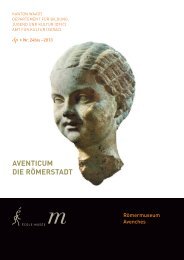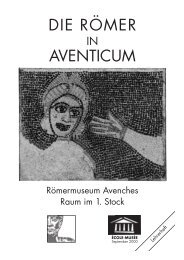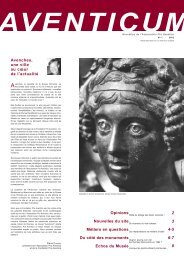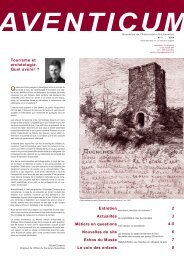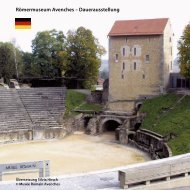Avenches – Roman Museum – Permanent Exhibition
Avenches – Roman Museum – Permanent Exhibition
Avenches – Roman Museum – Permanent Exhibition
You also want an ePaper? Increase the reach of your titles
YUMPU automatically turns print PDFs into web optimized ePapers that Google loves.
Ground Floor The Gallo-<strong>Roman</strong> Population of Switzerland and Their View of Death<br />
Ground Floor<br />
The Gallo-<strong>Roman</strong> Population of Switzerland and Their View of Death<br />
The Helvetii believed in some form of life after death.<br />
Before they died, some drew up a will settling their succession and giving<br />
instructions concerning their funeral, the choice of their grave and its upkeep, the<br />
funerary banquets, etc. The executor made sure that the will of the deceased was<br />
adhered to.<br />
The funerals were paid for either by the deceased or by their families. Less well<br />
off people joined a collegium funeraticium and regularly contributed to a funerary<br />
fund to cover their burial costs (purchase of ground, construction and upkeep of the<br />
tomb, periodical meals and offerings). Important people within a community were<br />
sometimes granted the honour of a public funeral.<br />
As stipulated by <strong>Roman</strong> law, the necropolises were situated along the main<br />
roads leading into and out of the towns. The deceased were taken to the cemetery<br />
on a bier carried by members of their immediate family and friends. Inhumation<br />
and cremation coexisted. However, the latter was predominant during the first<br />
two centuries AD. Infants whose teeth had not yet erupted were never cremated<br />
regardless of the period they lived in (display case 2). From the 3rd century AD<br />
onwards, inhumation became the rule, undoubtedly due to the influence of oriental<br />
cults and the rise of Christianity (display case 5).<br />
Cremations were carried out in the open air (1) where the dead were placed<br />
on a pyre along with their personal belongings (clothes, jewellery) and vessels<br />
containing food (display case 3). During the cremation, small flasks with aromatic<br />
plants and perfumes were thrown into the fire. Afterwards the bones were gathered<br />
and placed in urns, which were put into a grave together with some of the burnt<br />
objects (2). In most cases the urns were ceramic or glass vessels (display case 1),<br />
originally intended for domestic use, and sometimes wooden caskets were used<br />
(display case 3); such containers were rarely produced specifically for funerary<br />
purposes.<br />
In the case of inhumation (3) the deceased was placed in a wooden coffin<br />
(display case 4); sarcophagi made of stone or lead <strong>–</strong>were rare in this region <strong>–</strong>and<br />
only later became popular. The deceased was usually laid on his or her back, less<br />
frequently on the stomach or on the side. Offerings were often deposited in the<br />
coffin or the grave, but our perception remains incomplete since usually only<br />
objects made of non-perishable materials such as ceramics, glass or metal survived;<br />
traces of food are rarely found and basketry or objects made of leather, wood or<br />
cloth do not often survive.<br />
Once the tomb was closed, its location was marked, in order to remind the living<br />
to respect its inviolability and to honour the memory of the deceased (nos. 1 <strong>–</strong> 8).<br />
1<br />
2<br />
3<br />
7<br />
Ground Floor



